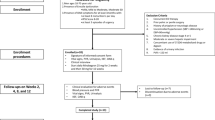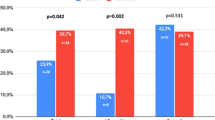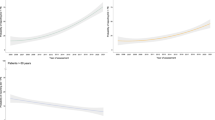Abstract
Sildenafil is one of two oral drugs approved for first-line treatment of erectile dysfunction (ED). Anecdotally, some young healthy men who wish to enhance their sexual performance are requesting or abusing sildenafil. In this randomized double-blind, placebo-controlled clinical study, we investigated the effect of sildenafil in young men without ED. A total of 60 young healthy men age 20–40 y with no reported ED were enrolled for this single-dose home-use study. Subjects had used no medication in the 6 months prior to the study. All had been engaged in a stable relationship for at least 3 months. After completing the IIEF-5 questionnaire, patients were randomized in a double-blind fashion to receive either one 25 mg tablet of sildenafil (group 1) taken prior to intercourse, or an identical placebo tablet (group 2). All subjects completed a questionnaire relating to their erectile quality. There were no differences between the two groups in the reported improvement of erection quality, 12/30 sildenafil vs 10/30 placebo (Fisher's test, P=0.79). Sildenafil caused a significant reduction of the postejaculatory refractory time (12/30 vs 4/30) (χ2 test, P=0.04). Sildenafil does not improve erections in young healthy men. Sildenafil should not be given to young healthy men to improve their erections and patients should be advised against recreational abuse of the drug. In this limited single-dose home study, sildenafil appears to reduce the postorgasmic refractory time. Although controlled studies are needed to evaluate the efficacy of erection-enhancing drugs in premature ejaculation, it is possible that sildenafil might be useful for this indication.
This is a preview of subscription content, access via your institution
Access options
Subscribe to this journal
Receive 8 print issues and online access
$259.00 per year
only $32.38 per issue
Buy this article
- Purchase on Springer Link
- Instant access to full article PDF
Prices may be subject to local taxes which are calculated during checkout

Similar content being viewed by others
References
Montorsi F et al. Efficacy and safety of fixed-dose oral sildenafil in the treatment of erectile dysfunction of various etiologies. Urology 1999; 53: 1011.
Goldstein I et al. Oral sildenafil in the treatment of erectile dysfunction. N Engl J Med 1998; 338: 1397.
Wespes E et al. Guidelines on erectile dysfunction. Eur Urol 2002; 41: 1–5.
Mansergh G et al. The circuit party men's health survey: findings and implications for gay and bisexual men. Am J Public Health 2001; 91: 953–958.
McLeod AL, McKenna CJ, Northridge DB . Myocardial infarction following the combined recreational use of viagra and cannabis. Clin Cardiol 2002; 25: 133–134.
Rosen RC et al. The International Index of Erectile Function (IIEF): a multidimensional scale for assessment of erectile dysfunction. Urology 1997; 49: 822–830.
Rosen RC et al. Development and evaluation of an abridged, 5-item vesion of the International Index of Erectile Function (IIEF-5) as a diagnostic tool for erectile dysfunction. Int J Impot Res 1999; 11: 319–326.
Dundar M et al. Evaluation of side effects of sildenafil in group of young healthy volunteers. Int Urol Nephrol 2001; 32: 705–708.
Aversa A et al. Effects of sildenafil (Viagra) administration on seminal parameters and post-ejaculatory refractory time in normal males. Hum Reprod 2000; 15: 131–134.
McMahon CG, Samali R . Pharmacological treatment of premature ejaculation. Curr Opin Urol 1999; 9: 553–561.
Fein RL . Intracavernous medication for treatment of premature ejaculation. Urology 1990; 4: 301–303.
Abdel-Hamid IA, El Naggar EA, EL Gilany AH . Assessment of as needed use of pharmacotherapy and the pause-squeeze technique in premature ejaculation. Int J Impot Res 2001; 13: 41–45.
Salonia A et al. A prospective study comparing paroxetine alone versus paroxetine plus sildenafil in patients with premature ejaculation. J Urol 2002; 168: 2486–2489.
Chen J, Mabjeesh NJ, Matzkin H, Greenstein A . Efficacy of sildenafil as adjuvant therapy to selective serotonin reuptake inhibitor in alleviating premature ejaculation. Urology 2003; 61: 197–200.
Acknowledgements
We thank Dr Eugenio Marro for Statistical analysis.
Author information
Authors and Affiliations
Corresponding author
Appendix A: Questionnarie
Appendix A: Questionnarie
Do you think that your sexual performance after the drug has been better? (YES/NO)
What aspects of your sexual performance do you believe improved?
-
a)
Easier erection?
-
b)
Erection more rigid?
-
c)
Erection lasted longer?
-
d)
More intense orgasm?
-
e)
A reduction of your *post-ejaculatory refractory time?
Did you have any side effects?
Would you take the drug again?
(*Refractory POST-EJACULATORY TIME: time to get another erection following ejaculation.)
Rights and permissions
About this article
Cite this article
Mondaini, N., Ponchietti, R., Muir, G. et al. Sildenafil does not improve sexual function in men without erectile dysfunction but does reduce the postorgasmic refractory time. Int J Impot Res 15, 225–228 (2003). https://doi.org/10.1038/sj.ijir.3901005
Received:
Revised:
Accepted:
Published:
Issue Date:
DOI: https://doi.org/10.1038/sj.ijir.3901005
Keywords
This article is cited by
-
HPLC–UV Chromatographic Methods for Detection and Quantification of Undeclared Withdrawn Synthetic Medications in Counterfeit Herbal Medicines with Confirmation by HPLC–PDA and Mass Spectrometry
Chromatographia (2018)
-
Sildenafil citrate use in Addis Ababa: characteristics of users and pharmacists’ dispensing practices
International Journal of Clinical Pharmacy (2018)
-
Early onset erectile dysfunction is usually not associated with abnormal cavernosal arterial Inflow
International Journal of Impotence Research (2013)
-
Current therapeutic strategies for premature ejaculation and future perspectives
Asian Journal of Andrology (2011)
-
Is there a role for phosphodiesterase type-5 inhibitors in the treatment of premature ejaculation?
International Journal of Impotence Research (2011)



